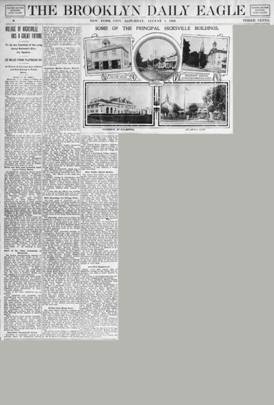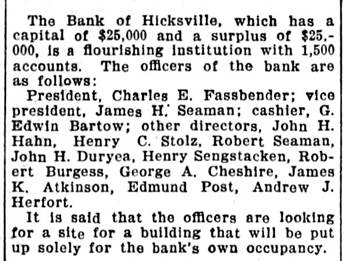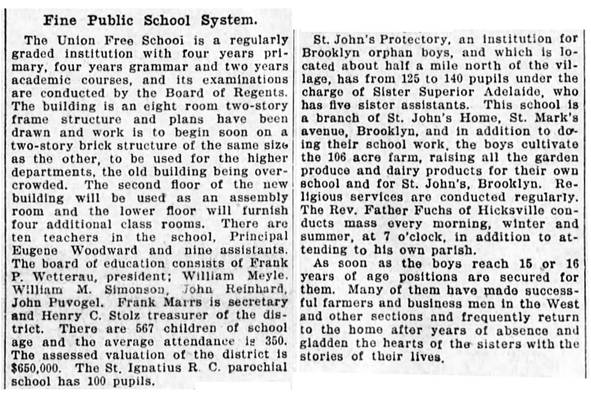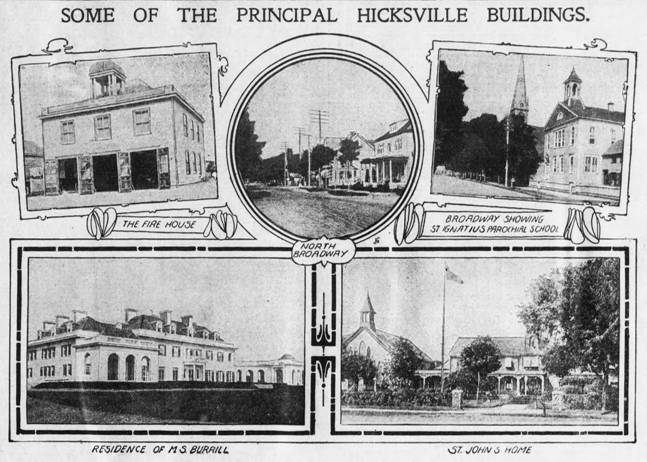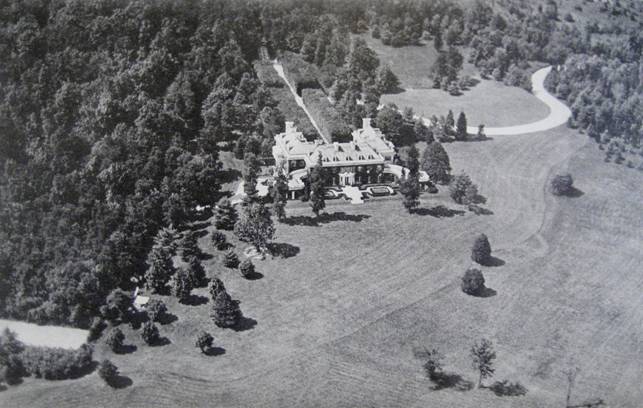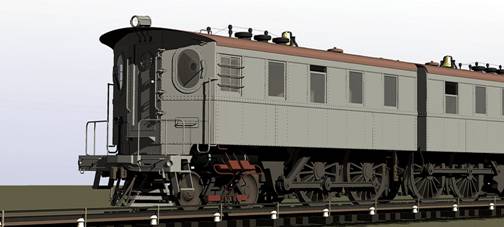It's
1908, and in about two years, the LIRR will start operating
electric-powered trains under the East River between
Change was in the air; any day now, the influx of
early-bird commuters would begin, and towns would start to blossom into
suburbs. Well, not really,
not in Hicksville or in any other town east of what today would be
central
If one could afford it, 1908 was a good time to buy
land, either for one's own use, or for resale at a profit to some
future developer. Thus,
newspapers (for which real estate ads always were a significant source
of revenue) were avidly promoting the building of suburban homes.
After all, new commuters meant multiple newspaper ads - ones
that attracted them to their new community and homes, and ones for the
city homes that they were leaving vacant.
One August Saturday, the Brooklyn Daily Eagle featured a portrait of Hicksville; it occupied
about half the front page of the
Note that the other half of the page (the portion that
is greyed out above) was primarily devoted to Rosyln and Port Jefferson.
It featured two large photos, one of a rustic "arched,
vine-draped bridge," and one of a harbor in a vale, dotted with sails.
The text
extolled romantic settings: lush woods, yachts on the sound, a lake bordered by
rhododendrons. As we shall
see here, the Eagle's
approach to
The headline for the Eagle's profile - shown at the very top of this Ancient
Hixtory article - focuses on the railroad, and the role that
To boil down what is stated and implied:
Is this overview accurate?
The overview goes on to state that the LIRR
has projected an astonishing 30% reduction in commuting time to
Much of what the profile states on
this topic speaks for itself, and will be presented here without
comment, but.... It is hard
to comprehend why a profile that was written to attract prospective
commuters devotes so much space to discussing local businesses that
employ local people. This is
especially true of the two businesses that are mentioned first, and
given the most exposure: gold/silver leaf beating, and the Heinz
factory. Both were very well
known at the time, but mentioning them in the profile does not seem an
effective way of attracting people who intended to work in Manhattan.
Obviously, this is not a simple
agricultural village that employs only farm laborers and people in
service industries. It makes
goods for regional markets, and in at least one instance, for European
markets.
For a village of 2,500 people,
Hicksville is looking busier and busier, even before the changes that
will be brought about by commuting have hit.
Prospective commuters can feel confident that the robust base of
service industries will make living in the village "work" for them.
Next in the profile is a description
of the village's agricultural base.
Of course, as the tide of suburbia will erode and eventually wash
away that base, it is ironic to find so much of this profile devoted to
agriculture.
The section on Industry and Commerce
concludes with some skeletal information about the new local bank:
A reminder: Elsewhere on the same
page, the Eagle reader sees a
view of Port Jefferson harbor, bounded by tree-covered hills, and a
subtitle about Roslyn that praises its "avenues of forest trees."
What appealing thing is said about Hicksville?
The text shown above is followed by a
cataloguing of the roads already paved, those scheduled to be paved,
those which have been surveyed for future paving, those which may be
paved later, etc. I cannot
imagine what a city dweller, looking to relocate for purposes of
commuting, would make of a place that saw macadam paving as its "chief
pride."
Following the litany of roads, the
profile returns to the topic of electrifying railroad service, and the
changes already underway to the LIRR
properties. Other than
electrification itself, the other changes were made, and they would
endure until track elevation work was undertaken many years later.
Construction of a new, larger station,
on the roomier land west of Jerusalem Avenue, and the simultaneous
broadening of the LIRR
right-of-way, was necessary to handle the anticipated increase in
commuter traffic on the two-track Main Line.
The profile next speaks about
utilities. It lists the
number of streetlights and their candlepower, and the number of
hydrants, and the range of water pressures measured at their nozzles.
It credits the Village
Improvement Association for its undertaking the introduction of new
curbs and sidewalks, mentioning its officers: John H. Hahn, H. J.
Nicklaus, and John Reinhard.
Beneath a somewhat perplexing heading,
the portrait concludes by depicting the Fire Department, tacking on a
terse partial listing of the fraternal organizations then active in
Hicksville:
The upcoming Firemen's Association
convention and parade is mentioned - it probably was of minimal
interest to prospective commuters, but it certainly was an event that
brought many visitors to town.
Now we know what the Eagle's readers were told in an effort to sell them on Hicksville.
Keeping that in mind, let's finally look at those eye-catching
pictures that were placed up-front to entice people into reading the
profile.
The photograph of the 1906 Fire House
is well-known to many readers, many of whom know that the structure
eventually was moved across Marie Street, renovated extensively, and
turned into Peppercorn's.
North Broadway (a raised crossing gate can be seen left of the
picture's center) displays the rough macadam paving of which the town
fathers felt compelled to brag. Today,
the photo of the old St. Ignatius school building, with its quaint
cupola, and the Protectory look rather charming.
Marketers sometimes say, "Don't sell the steak; sell the sizzle!"
Well, compared to some other would-be suburbs, 1908's
Hicksville seems to have been awfully low on sizzle.
Clearly, it needed something more in that department.
Hence, we have the final picture (lower left in the group).
The "estate next door" belonged to
William K. Vanderbilt. Obviously, the Burrill
Residence was not located in Hicksville.
In 1900, the Pennsylvania Railroad had bought a controlling interest in the
Long Island. It had
planned to send mainland passenger trains under the Hudson into
Manhattan - where, unfortunately, it could find no real estate on
which to park and service its trains.
Getting control of the LIRR allowed it to tunnel under the East River, and purchase land
for a huge train yard in Sunnyside.
The arrangement not only got it a Manhattan-accessible yard; it
also positioned the Pennsy as
the parent of the Long Island,
which it would exploit, by having the LIRR
lease or purchase some of the Pennsy's
surplus cars and engines.
What was being tested?
A prototype electric locomotive, the testing of which would yield
data to be used to design a new long-haul electric hauler.
The Pennsylvania
was happy to continue using its steam engines over much of its coal-rich
territory. In the
train-intense Northeast Corridor, however, electric locomotives - if
they could be built sufficiently powerful - could haul trains more
economically and more quickly than could steam locomotives.
Electric locomotives never needed to "waste time" taking on
coal or water, or dumping out all the ash they had accumulated.
After stopping at a station, their trains accelerated more
quickly than trains hauled by steam locomotives.
That meant that at every station stop, they might shave a few
more minutes off the overall length of a journey.
Moreover, they would traverse the New York tunnels safely,
belching neither steam nor dangerous byproducts of coal combustion.
The route used for the testing ran
over the Central Branch, from Island Trees, past Garden City, and joined
the LIRR Main Line west of New
Hyde Park. It then ran
through Jamaica into Manhattan, and continued west under the Hudson to
New Jersey. It ended at what
later would be known as Manhattan
Transfer (try not to think of the singing group).
This was a special-purpose station at which, until Northeast
Corridor passenger service was completely electrified, Pennsylvania
passengers transferred between electric Manhattan trains and steam
mainland trains.
The Pennsylvania already had evaluated smaller electric locomotives, designed to shunt cars around railroad yards, but building a big loco to reliably haul heavy, fast mainline trains was very different. Many new things had to be tested, including its ability to stay on the rails at high speed. The last comment is not facetious - in the past, new types of steam locomotives occasionally had experienced problems speeding through certain types of track arrangements. The railroad applied its steam-based knowledge where it could, but so much was new about electric locomotives that thoroughly testing a prototype was considered a necessary step. It helped that the chosen wheel arrangement mimicked that of a familiar type of steam locomotive. The
testing went well. When it
was finished, the findings and recommendations were used to further
develop the prototype's design principles and components into a more
robust, dual-unit production locomotive.
When introduced in 1910, it was the most powerful locomotive ever
put into service anywhere in the world.
And by the way, it took power only from third rails, not from
overhead wire.
That out-of-place photo of the Burrill
estate (which, after falling into disrepair, was later revitalized as
the Meadow Brook Club) fooled no one.
The overhead wire on the Central Branch was taken down as
planned, and not stretched all the way to Hicksville (as was not
planned). When
electrification did arrive, it came through a third rail, and in terms
of the Eagle's profile, it
was very, very late indeed. The
demise of the two most prestigious local industrial employers - the
gold leaf shops and the large Heinz plant - was a heavy blow for the
village to weather. Beetles
and builders abruptly put an end to almost all the local farms.
Mercifully, the vaunted macadam roads eventually were overtaken
by progress, as were the flagstone sidewalks.
No one has been seen counting Hicksville's streetlights for a
long, long time.
|
|||||||||||||||||||||||||||||||||||||||||||||||||||||||||||

